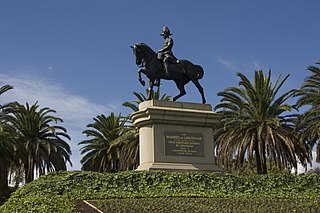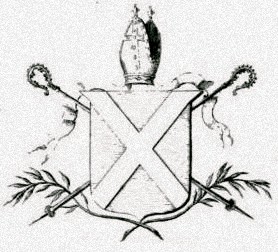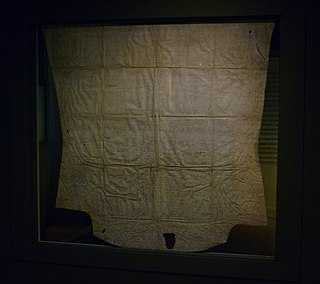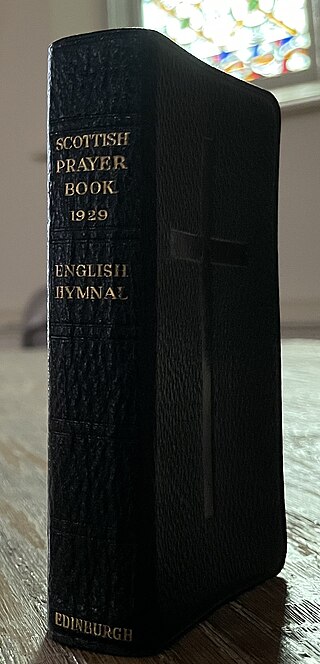The Scottish Episcopal Church is a Christian denomination in Scotland. Scotland's third largest church, the Scottish Episcopal Church has 303 local congregations. It is also an ecclesiastical province of the Anglican Communion.

St Giles' Cathedral, or the High Kirk of Edinburgh, is a parish church of the Church of Scotland in the Old Town of Edinburgh. The current building was begun in the 14th century and extended until the early 16th century; significant alterations were undertaken in the 19th and 20th centuries, including the addition of the Thistle Chapel. St Giles' is closely associated with many events and figures in Scottish history, including John Knox, who served as the church's minister after the Scottish Reformation.

Janet "Jenny" Geddes was a Scottish market-trader in Edinburgh who is alleged to have thrown a stool at the head of the minister in St Giles' Cathedral in objection to the first public use of the Church of Scotland's revised version of the Book of Common Prayer, the 1637 Scottish Prayer Book. The act is reputed to have sparked the riot that led to the Wars of the Three Kingdoms, which included the English Civil War.

James Pittendrigh MacGillivray was a Scottish sculptor. He was also a keen artist, musician and poet. He was born in Inverurie, Aberdeenshire, the son of a sculptor, and studied under William Brodie and John Mossman. His works include public statues of Robert Burns in Irvine, Lord Byron in Aberdeen, the 3rd Marquess of Bute in Cardiff, John Knox in Edinburgh's St Giles Cathedral, and William Ewart Gladstone in Coates Crescent Gardens, Edinburgh.

William Cunningham, 9th Earl of Glencairn (1610–1664), was a Scottish nobleman, Lord Chancellor of Scotland, and a cavalier. He was also the chief of Clan Cunningham.

Linlithgow is a town in West Lothian, Scotland. It was historically West Lothian's county town, reflected in the county's historical name of Linlithgowshire. An ancient town, it lies in the Central Belt on a historic route between Edinburgh and Falkirk beside Linlithgow Loch. The town is situated approximately 20 miles (32 km) west of Edinburgh.

Clan Hannay is a Lowland Scottish clan.

William Birnie Rhind RSA (1853–1933) was a Scottish sculptor.
David Lindsay was a Church of Scotland minister and prelate active in the seventeenth-century.

The Bishops' Wars were two separate conflicts fought in 1639 and 1640 between Scotland and England, with Scottish Royalists allied to England. They were the first of the Wars of the Three Kingdoms, which also include the First and Second English Civil Wars, the Irish Confederate Wars, and the 1650 to 1652 Anglo-Scottish War.

Covenanters were members of a 17th-century Scottish religious and political movement, who supported a Presbyterian Church of Scotland and the primacy of its leaders in religious affairs. It originated in disputes with James VI and his son Charles I over church organisation and doctrine, but expanded into political conflict over the limits of royal authority.

The Archdiocese of St Andrews was a territorial episcopal jurisdiction of the Catholic Church in early modern and medieval Scotland. It was the largest, most populous and wealthiest diocese of the medieval Scottish Catholic church, with territory in eastern Scotland stretching from Berwickshire and the Anglo-Scottish border to Aberdeenshire.

John RhindARSA (1828–1892) was a Scottish sculptor, based in Edinburgh. He was born in Banff the son of a master mason. He was trained under Alexander Handyside Ritchie (1804–1870). He served this apprenticeship in a yard at 4 East Broughton Place.

Alison Kinnaird MBE, MA, FGE is a glass sculptor, Celtic musician, teacher and writer born in Edinburgh, Scotland. She is one of the foremost and most original modern glass engravers in Scotland.

The National Covenant was an agreement signed by many people of Scotland during 1638, opposing the proposed reforms of the Church of Scotland by King Charles I. The king's efforts to impose changes on the church in the 1630s caused widespread protests across Scotland, leading to the organisation of committees to coordinate opposition to the king. Facing royal opposition, its leaders arranged the creation of the National Covenant to bolster the movement by tapping into patriotic fervour. It became widely adopted throughout most of Scotland with supporters henceforth known as Covenanters.

James Hannay was a Scottish clergyman who served as Dean of St Giles Cathedral. He is best remembered as the unfortunate clergyman struck on the head by a stool thrown by Jenny Geddes after reading from the English Book of Common Prayer.
David Blair (1637–1710) was a Scottish minister of the Church of Scotland who served as minister of St Giles Cathedral and was Moderator of the General Assembly in 1700.

The 1929 Scottish Prayer Book is an official liturgical book of the Scotland-based Scottish Episcopal Church. The 1929 edition follows from the same tradition of other versions of the Book of Common Prayer used by the churches within the Anglican Communion and Anglicanism generally, with the unique liturgical tradition of Scottish Anglicanism. It contains both the forms of the Eucharistic liturgy and Daily Office, as well as additional public liturgies and personal devotions. The second major revision of the Book of Common Prayer following the full independence of the Scottish Episcopal Church, the 1929 Scottish Prayer Book succeeded the 1912 edition and was intended to serve alongside the Church of England's 1662 prayer book.

The 1637 Book of Common Prayer, commonly known as the Scottish Prayer Book or Scottish liturgy, was a version of the English Book of Common Prayer revised for use by the Church of Scotland. The 1637 prayer book shared much with the 1549 English prayer book—rather than the later, more reformed English revisions—and contained Laudian liturgical preferences with some concessions to a Scottish and Presbyterian audience. Charles I, as King of Scotland and England had wished to impose the liturgical book to align Scottish worship with that of the Church of England. However, after a coordinated series of protests—including the legendary opposition by Jenny Geddes at St Giles' Cathedral—the 1637 prayer book was rejected.















